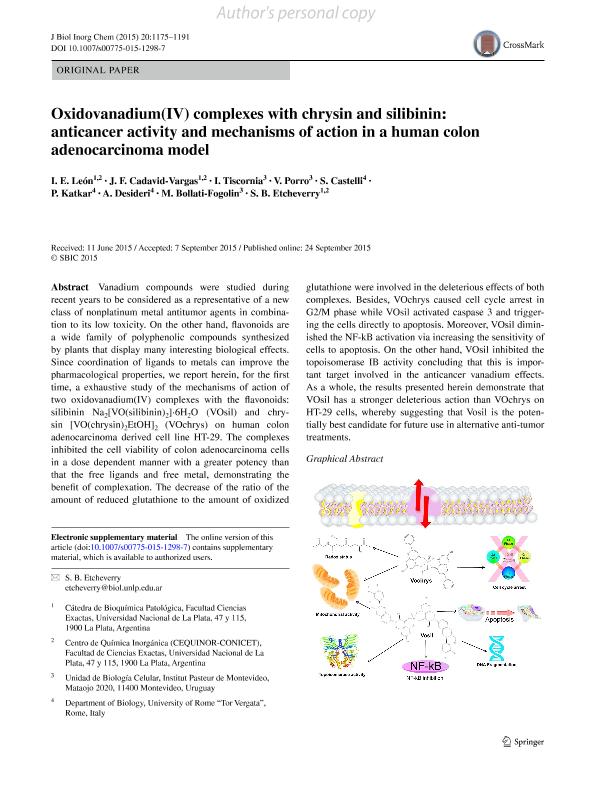Artículo
Oxidovanadium(IV) complexes with chrysin and silibinin: anticancer activity and mechanisms of action in a human colon adenocarcinoma model
Leon, Ignacio Esteban ; Cadavid Vargas, Juan Fernando
; Cadavid Vargas, Juan Fernando ; Tiscornia, Ines Silvia
; Tiscornia, Ines Silvia ; Porro, V.; Castelli, S.; Katkar, P.; Desideri, A.; Bollati Fogolin, M.; Etcheverry, Susana Beatriz
; Porro, V.; Castelli, S.; Katkar, P.; Desideri, A.; Bollati Fogolin, M.; Etcheverry, Susana Beatriz
 ; Cadavid Vargas, Juan Fernando
; Cadavid Vargas, Juan Fernando ; Tiscornia, Ines Silvia
; Tiscornia, Ines Silvia ; Porro, V.; Castelli, S.; Katkar, P.; Desideri, A.; Bollati Fogolin, M.; Etcheverry, Susana Beatriz
; Porro, V.; Castelli, S.; Katkar, P.; Desideri, A.; Bollati Fogolin, M.; Etcheverry, Susana Beatriz
Fecha de publicación:
09/2015
Editorial:
Springer
Revista:
Journal of Biological Inorganic Chemistry
ISSN:
0949-8257
Idioma:
Inglés
Tipo de recurso:
Artículo publicado
Clasificación temática:
Resumen
Vanadium compounds were studied duringrecent years to be considered as a representative of a newclass of nonplatinum metal antitumor agents in combinationto its low toxicity. On the other hand, flavonoids area wide family of polyphenolic compounds synthesizedby plants that display many interesting biological effects.Since coordination of ligands to metals can improve thepharmacological properties, we report herein, for the firsttime, a exhaustive study of the mechanisms of action oftwo oxidovanadium(IV) complexes with the flavonoids:silibinin Na2[VO(silibinin)2]·6H2O (VOsil) and chrysin[VO(chrysin)2EtOH]2 (VOchrys) on human colonadenocarcinoma derived cell line HT-29. The complexesinhibited the cell viability of colon adenocarcinoma cellsin a dose dependent manner with a greater potency thanthat the free ligands and free metal, demonstrating thebenefit of complexation. The decrease of the ratio of theamount of reduced glutathione to the amount of oxidized glutathione were involved in the deleterious effects of bothcomplexes. Besides, VOchrys caused cell cycle arrest inG2/M phase while VOsil activated caspase 3 and triggeringthe cells directly to apoptosis. Moreover, VOsil diminishedthe NF-kB activation via increasing the sensitivity ofcells to apoptosis. On the other hand, VOsil inhibited thetopoisomerase IB activity concluding that this is importanttarget involved in the anticancer vanadium effects.As a whole, the results presented herein demonstrate thatVOsil has a stronger deleterious action than VOchrys onHT-29 cells, whereby suggesting that Vosil is the potentiallybest candidate for future use in alternative anti-tumortreatments.
Palabras clave:
Metal Based Drug ·
,
Ht-29 Cells
,
· Flavonoids ·
,
Vanadium
Archivos asociados
Licencia
Identificadores
Colecciones
Articulos(CEQUINOR)
Articulos de CENTRO DE QUIMICA INORGANICA "DR. PEDRO J. AYMONINO"
Articulos de CENTRO DE QUIMICA INORGANICA "DR. PEDRO J. AYMONINO"
Citación
Leon, Ignacio Esteban; Cadavid Vargas, Juan Fernando; Tiscornia, Ines Silvia; Porro, V.; Castelli, S.; et al.; Oxidovanadium(IV) complexes with chrysin and silibinin: anticancer activity and mechanisms of action in a human colon adenocarcinoma model; Springer; Journal of Biological Inorganic Chemistry; 20; 7; 9-2015; 1175-1191
Compartir
Altmétricas



